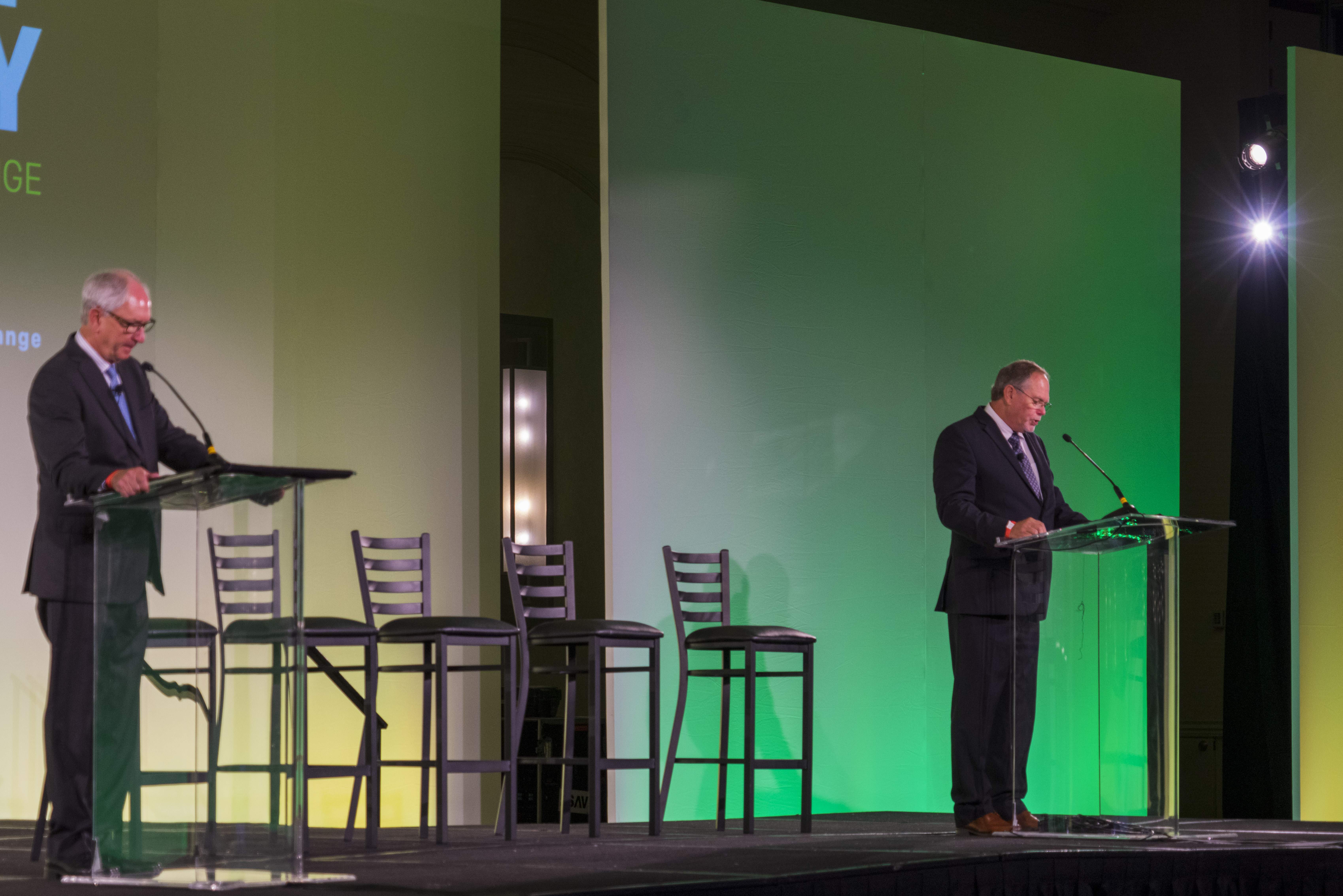
USSEC Chair Monte Peterson and SSGA President Robert Sinner kicked off the 2021 U.S. Soy Global Trade Exchange and Specialty Grains Conference Wednesday morning in St. Louis. The event is being held in a hybrid format this year. (Photo credit: Joseph Hopper/Iowa Soybean Association)
Soy takes center stage: U.S. Soy Global Trade Exchange and Specialty Grains Conference kicks off
August 26, 2021
USDA Foreign Agriculture Service Administrator outlines top priorities
The largest annual gathering of buyers is back meeting face-to-face. The U.S. Soy Global Trade Exchange (GTE) and Specialty Grains Conference kicked off at the Gateway City — St. Louis — Wednesday. More than 1,500 producers, industry experts, stakeholders and buyers attended in 2021, approximately 300 of which choosing to do so in person.
“It’s clear collaboration is the best way to make things happen,” Robert Sinner, Specialty Soya and Grains Alliance president, said. “That’s true whether it’s working with your neighboring farm or buyers from another continent.”
While the preference is to discuss soybean quality and quantities in person, some of the information being delivered still stings.
“I’ve been able to talk to several buyers and they’re not thrilled with what I have to say,” said Tim Bardole, who farms near Rippey and is representing the Iowa Soybean Association at the GTE. “In a group like what we have gathered here, they want high yields, high supplies which will end up with lower soybean prices for them but I’m not seeing that. There are some places which are probably going to have fantastic yields, but when you average it all out I’m thinking it’s going to be below what the estimates are just because of the heat we’ve had the last couple weeks.
He continued, “But I think overall, there’s going to be a decent supply of U.S. soybeans to export.”
Bardole, ISA At Large director and immediate past president, said his soybean crop is struggling again this year. After being hit last year by a derecho, he and many other central Iowa farmers have missed timely rains. The crop is currently limping to the finish line.
“It’s dry and the soybeans in our area are showing a lot of sudden death and as you travel around even especially north of where I live you see a lot of yellow fields,” Bardole said. “It’s way too soon for them to be maturing. They’re just dying which will end in lower yields, just because of seed size.”
U.S. ag leaders are also setting the stage for a week of productive discussions by emphasizing the industry’s work to provide a sustainable and reliable supply of soybeans.
“I want to thank you all for being an innovator and being a leader of ag commodity groups in agriculture,” USDA Foreign Agriculture Service Administrator Daniel Whitley said. “As you’re well aware, climate change, sustainability is a major priority for this administration as well as here at the USDA. I wanted to commend you all for leading the U.S. Sustainability Alliance the last four years.”
The U.S. soy industry’s innovative work related to improving relationships internationally with emerging markets, highlighting World Initiative for Soy in Human Health (WISHH) as an example, also drew praise from Whitley, who appeared virtually Wednesday morning to help open the event.
The FAS administrator reaffirmed the department’s goal of serving the needs of buyers of U.S. soy.
“I want to make sure we are the top customer service provider in all U.S. government,” he said.
Whitley vowed to use statistics and analysis of U.S. soybean quality and quantities to help make sales to global customers. He said the FAS team has the back of U.S. soybean farmers given the department’s deep love and appreciation for agriculture and trade.
“We might grow old, but we don’t grow anything tangible at FAS,” Whitley mused. “Our focus is setting standards and conditions that help sell what U.S. farmers grow.”
Hearing Whitley’s introduction in person at GTE, Bardole said he’s been impressed by the work of FAS.
“The FAS people in these countries, they know what’s going on in the country,” Bardole said. “They’re very well respected by the people that they’re dealing with and that respect then comes back to the U.S. farmer. The FAS gives them the resources some extra knowledge base to help them be more efficient and in turn it gives a good relationship with the U.S. and U.S. soy. The U.S. farmers are very respected in these export countries.”
Look for more in-depth coverage of this year’s U.S. Soy Global Trade Exchange in the October edition of the Iowa Soybean Review.
Back